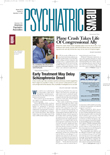APA is launching a new fellowship program designed to spur the interest of residents in the critical shortage area of child and adolescent psychiatry.
Propelled by statistics showing that while there are approximately 15 million children in the United States with psychiatric disorders but only 6,800 child and adolescent psychiatrists to treat them, APA is responding to the need for more specialists through the new APA/Shire Child and Adolescent Psychiatry Fellowship.
APA’s announcement of the fellowship states that it is being established “to promote interest among general psychiatry residents in pursuing careers in child and adolescent psychiatry and to build future leaders in this area by providing specialized educational opportunities that would otherwise be unavailable to them.”
The fellowship is a two-year program, with four residents to be selected to participate. Each will work with a mentor. As part of the program, the fellows will be able to attend APA’s 2003 and 2004 annual meeting with travel and meeting expenses paid. They will be able to network with the field’s leading lights, attend sessions on various aspects of child and adolescent psychiatry, and present a workshop to be included in the scientific program for the 2004 annual meeting in New York.
They will also be invited to attend meetings of the APA Council on Children, Adolescents, and Their Families during their two years in the program.
During the second year, fellowship participants will be expected to mentor their colleagues beginning their first year of the program.
Deborah Hales, M.D., director of APA’s Division of Education, Minority, and National Programs, said the new fellowship is especially timely as the dimensions of the crisis dawns on those both inside and outside the field of psychiatry.
“The critical shortage of child and adolescent psychiatrists,” Hales said, “means that on average each [child and adolescent] psychiatrist is responsible for treating nearly 3,000 patients per year—a tall order for even the most hard-working physician. . . .”
Lois Flaherty, M.D., chair of APA’s Council on Children, Adolescents, and Their Families, pointed out that the shortage of these specialists is “highlighted by new discoveries in the field that demonstrate the importance of early detection and treatment of psychiatric disorders—both those that have their onset during childhood and those that start in adult life but have precursors earlier in life.”
The program is open to psychiatry residents in their PGY-1 to PGY-3 years. They must be in a psychiatry residency program during both years of the fellowship.
Fellowship applicants must submit an application and letter of interest that explains the applicant’s experience and intended career path, along with a curriculum vitae and a letter of support from his or her residency training director, which should include a description of the resident’s potential contribution to the field.
APA is sending applications and program descriptions to all psychiatry training directors and department chairs. Information will also appear on the APA residents’ list serve. A section describing the program will also be added to the APA Web site at www.psych.org. The deadline for submitting applications is December 16.
Financial support for the fellowship comes through an unrestricted educational grant from Shire Pharmaceuticals. Oversight for the program will be the responsibility of the APA Council on Children, Adolescents, and Their Families, and it will be administered by the project director of APA’s Office of Children’s Affairs.
More information is available by contacting Jane Edgerton, director of the APA Office of Children’s Affairs, by phone at (202) 682-6857 or e-mail at [email protected]. ▪
